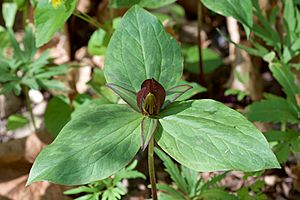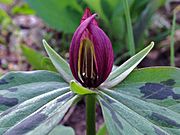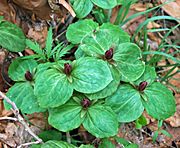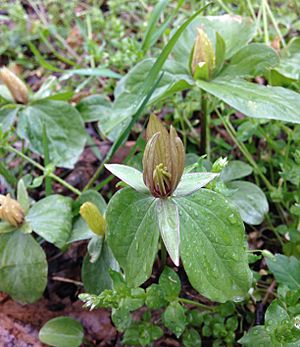Toadshade facts for kids
Quick facts for kids Toadshade |
|
|---|---|
 |
|
| In Newton County, Arkansas | |
| Conservation status | |
| Scientific classification | |
| Genus: |
Trillium
|
| Species: |
sessile
|
| Synonyms | |
|
Synonymy
Esdra sessilis (L.) Salisb.
Phyllantherum sessile (L.) Nieuwl. Trillium isanthum Raf. Trillium longiflorum Raf. Trillium membranaceum Raf. Trillium rotundifolium Raf. Trillium tinctorium Raf. Trillium sessile var. boreale Nutt. Trillium sessile f. viridiflorum Beyer |
|
Trillium sessile, also known as toadshade, sessile trillium, or toad trillium, is a beautiful spring wildflower. It grows year after year, making it a perennial plant. You can find it in the central eastern United States and the Ozarks region.
Toadshade is special because its flower sits directly on the plant's three large leaves, called bracts. Unlike some other Trillium plants, its flower has no stalk. The flower can sometimes smell a bit strange, which helps attract insects. The bracts are often mottled, meaning they have patches of light and dark green. The name sessile comes from a Latin word meaning "low sitting," which describes its stalkless flower.
Contents
What Does Toadshade Look Like?
Trillium sessile has three oval-shaped leaves, or bracts. These can be up to 10 centimeters (about 4 inches) long and 8 centimeters (about 3 inches) wide. The bracts are usually green, sometimes with a bluish tint. They often have a mottled pattern that fades as the plant gets older.
Each toadshade flower has three sepals (leaf-like parts under the petals) and three petals. The petals are usually maroon or brownish. Sometimes they can be green or yellowish-green. They grow up to 3.5 centimeters (about 1.4 inches) long. This plant blooms between May and June.
Toadshade grows in clumps from a thick underground stem called a rhizome. This rhizome helps the plant store energy. The parts of the plant above ground usually die back by mid-summer. However, they might stay longer in places that remain moist.
-
Toadshade growing in Licking County, Ohio
Types of Toadshade
Sometimes, toadshade plants have green or yellow-green flowers. These are less common. People used to give them a special name, Trillium sessile f. viridiflorum. However, today, most plant experts consider them to be the same species as other Trillium sessile.
There was also an old name, Trillium sessile var. luteum. This name can be confusing because it actually refers to a different plant called Trillium luteum, not a type of Trillium sessile.
Where Does Toadshade Grow?
Toadshade prefers to grow in rich, moist forests. You can also find it in woods with limestone soil. It grows well in floodplains and along fence lines. This plant can even survive if animals lightly graze on it.
How Does Toadshade Reproduce?
The foul-smelling flowers of the toadshade plant attract its main pollinators: flies and beetles. These insects help the plant make seeds.
The seeds of the toadshade have a special fatty part called an elaiosome. This part attracts ants and wasps, like those from the Vespula group. When ants carry the seeds away to eat the elaiosome, they help spread the seeds to new places. This helps the plant grow in more areas.
Protecting Toadshade
Toadshade is a plant that needs our help in some areas. It is listed as a threatened species in Michigan. It is also an endangered species in New York. These states are at the northern edge of where the plant naturally grows.
Toadshade faces several challenges. Its habitat (the place where it lives) is sometimes broken up into smaller pieces. Deer also eat the plants. Invasive species are another problem. These are plants or animals that are not native to an area and can harm the local ecosystem. Examples include Amur honeysuckle and wild boar.
Uses of Toadshade
Some people have said that the cooked green parts of this plant can be eaten in an emergency. However, it's important to know that the entire plant, especially its root, can make you vomit. The fruit is also thought to be poisonous.
Historically, Trillium sessile was sometimes used in traditional medicine to treat tumors. There are also stories of it being used by Native American tribes, like the Yuki and Wailaki, for boils or as a general remedy. However, these tribes lived in California, where this plant does not naturally grow. So, it's unlikely they used this specific plant.
Toadshade is sometimes planted in woodland wildflower gardens. But like many trilliums, it often does not survive well when moved from the wild.
Images for kids
See also
 In Spanish: Trillium para niños
In Spanish: Trillium para niños









